Archive for ‘Psychological’ Category
Count on Accountability: 5 Productivity Support Solutions

Procrastination strikes for many reasons: perfectionism, fear of failure, lack of inspiration. Sometimes, there’s no apparent reason why we procrastinate on completing a task or working on a project; we just know that do and we wish that we didn’t.
Canadian psychology professor and all-around expert on procrastination, Timothy Pychyl, author of Solving the Procrastination Puzzle: A Concise Guide to Strategies for Change, explains that procrastination isn’t just delay. He explains that procrastination is “a voluntary delay of an intended act,” one where the person procrastinating is cognizant that the delay is going to have a cost, whether that cost is financial, interpersonal, professional, legal, or otherwise.
When we procrastinate, we know that there’s no upside; we aren’t merely weighing a logical choice between two options of equal value. It’s less, “geez, how can I decide on whether to go on this romantic anniversary date with my spouse or prepare for my presentation this week?” and more, “Eek, I’m feeling icky about doing this thing for some reason and I’ll latch on to any random thing, like bingeing a sit-com I’ve seen in its entirety three times!”
Experts like Pychyl have found that at its base, procrastination is “an emotion regulation strategy” – a way to cope with a particular emotion while failing to self-regulate and perform a task we know we need to do. We convince ourselves we’d rather feel good now, thereby causing more trouble for our future selves.
And be assured, professional organizers and productivity experts are not immune. I’ll admit that I hit a Pandemic Productivity Wall in February on a project I could normally complete in my sleep, but every time I sat down to attempt it, I couldn’t focus and got anxious. We all know how this feels.
Today, we’re going to look at one particular well-researched strategy for outmaneuvering our procrastinating selves: accountability.
So, What Is Accountability?
At its most basic, accountability is having some external source hold your feet to the metaphorical fire. It can work in many ways.
As professional organizers, my colleagues and I often perform a technique popularized in the ADHD community called body doubling. We literally work side-by-side, often quietly folding clothes or sorting papers while clients sort through their possessions or pay their bills. When you’re on your own, you might find ways to delay or distract yourself, but when someone is there, investing their time in you (and you’re investing your time and money to achieve your goals), body doubling helps you push past the anxiety and be more productive.
Accountability can be a matter of having someone check in with you. Knowing that someone else is taking an active role in caring whether you get a task done (but who doesn’t directly benefit from you completing the task, so it doesn’t feel like nagging) can get you over the hump. It’s all about support.
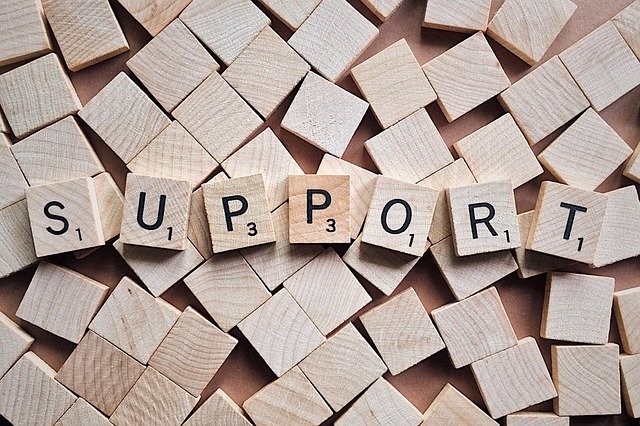
Image by Wokandapix from Pixabay
Accountability can be accomplished by dangling the carrot to give you an emotional reward, or threatening with the stick, yielding an unfortunate experience or event even worse than the result of your procrastination.
There are five main ways to get accountability. Not all will work for every person or in every situation, so it’s worth experimenting.
FIND AN ACCOUNTABILITY PARTNER
The first category for getting accountability support is to seek out one individual at no financial cost.
- A close friend or loved one – Getting support from someone close to you works best when the stakes are low and what you need most is a cheerleader. Let’s say that you’ve literally hit the wall in your closet – all the walls – and there’s just too much clothing in not enough space. Every time you attempt to start purging your closet, the prospect of trying things on and discarding much-loved clothes slows you down.
In the parlance of Grey’s Anatomy, call “your person,” the one you could call for anything.
Explain to your friend what you want to do. Agree to talk at the start, and set the alarm for a reasonable amount of time, perhaps 45 minutes. When the alarm goes off, you call or text her (or she calls or texts you, depending on what you’ve decided), and you can report in. If you had trouble deciding about a few items, you can have an ad hoc fashion show, or otherwise seek your friend’s advice.
You see, the sneaky thing about accountability is that many of us are bad at doing things for ourselves. But the minute we know that someone else cares whether we accomplish the task, even if they have no inherent skin in the game, we tend to push forward to accomplish it.
Note: this isn’t applicable to everyone. While many of would fall into Gretchen Rubin’s Obliger or Upholder categories, per her Four Tendencies of responding to expectations, there are a handful of rebels and Questioners out there who chafe at fulfilling others’ expectations. If that’s you, accountability may still work for you, but more because of the camaraderie than the idea of fulfilling implied obligations to someone else.
I’ve had a number of accountability buddies over the years, including professional organizer Jeri Dansky, with whom I used to trade daily accountability emails, and my long-time accountability partner, Dr. Melissa Gratias. I have a virtual meeting once a month with Melissa and her dog Dobby, where we review what we said what we would accomplish and set new goals. This isn’t for time-specific tasks, but more for having a partner-in-crime to keep focused on growing our businesses.
Not everyone feels comfortable asking a close friend or relative for this kind of support; sometimes we fear feeling too judged by the people we like the most. (True story: I once told PaperMommy, “I value your opinion too much to actually want to hear it!”)
Sometimes we fear feeling judged by the people we like the most. (True story: I once told @PaperMommy, 'I value your opinion too much to actually want to hear it!)' Share on XIf you’d still like to find just one accountability buddy, whether for an ad hoc task or perhaps for a longer term partnership, you may be more comfortable setting up an accountability relationship with someone you don’t know as well, like a colleague. That little bit of competitive friction may push you through your procrastination.
Other opportunities you might try:
- Put a post on social media and ask if anyone would like a short-term accountability partnership (for an hour, a day, a week…)
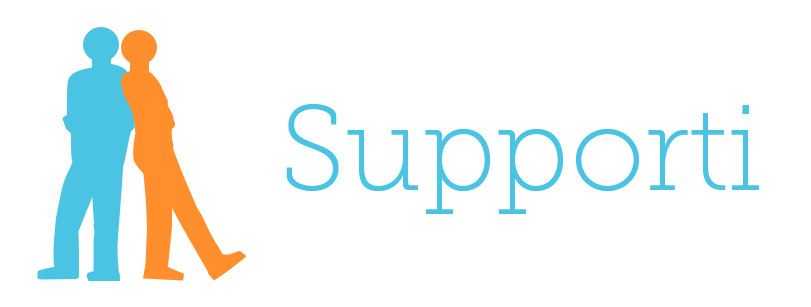
- Try an app like Supporti, which pairs you up with a one-on-one buddy for one week at a time.

- For your professional endeavors, consider Focusmate, a virtual co-working model where you “work by connecting to other professionals who have committed to being accountable for finishing their most important work.”
Focusmate claims that this style of virtual coworking “harnesses pillars of psychology proven to boost productivity 200-300%.” You set the time(s) you want to be productive, and Focusmate sends you an email to confirm your virtual session. (You need to use Chrome on your computer, or Chrome or Safari on mobile.)
At the appointed time, you greet your partner, declare your goal, and work for 50 minutes, quietly but in tandem, approximating the body doubling model. You get three focused sessions in a week for free. Read more about this platform in Mel Magazine‘s I Let A Stranger Watch Me Work For a Day — And I’ve Never Been More Productive. (As an added bonus, I was surprised and delighted to see that Melissa Gratias was interviewed!)
JOIN AN ACCOUNTABILITY GROUP
Support groups are popular for a reason. Whether you’re talking about a Twelve Step program, a lifestyle program like Weight Watchers, or school or professional groups, members support one another toward a like-minded goal. This is ideal when you’re not looking for someone to help you stick with a task, but progress toward a larger life achievement. Consider:
- Mastermind groups seem like a newfangled option, but they’ve actually been around for almost a century, when they were proposed by Napoleon Hill in his 1925 book The Law of Success, and explained in more detail in his 1937 book Think and Grow Rich. Basically, mastermind groups are peer-to-peer mentoring group; everyone’s a mentor, and everyone’s a protégée. Members present their professional concerns, brainstorm together, offer input…and provide accountability.
Golden Circle, the veteran members of NAPO, offered us the opportunity to form our own mastermind groups a few years ago. I’m delighted to be a member of the PM Crew (we meet in the evenings because Paper Doll is not a morning person), which includes my colleagues Maria White in Ashburn, VA, Nancy Haworth in Raleigh, NC, Yve Irish in Rochester, NY, and Karen Sprinkle (just up the highway from me) in Knoxville, TN. We meet once a month by phone or Zoom, send weekly group emails recapping our progress on the prior week’s goals and setting goals for the upcoming week, and share LOTS of supportive texts. Yve, in particular, is a star when it comes to sending supportive memes, gifs, and bitmojis:

- Study groups have been around since at least ancient Greece. Law schools and MBA programs, in particular, promote the use of study groups: they study cases, debate approaches, and help one another maintain focus and keep pace. Whether you’re a freshman in college or taking Bible study classes, whatever you’re trying to learn, forming a study group can help you ensure that you’ll hit your goals and gain confidence in both the content and your own skills.
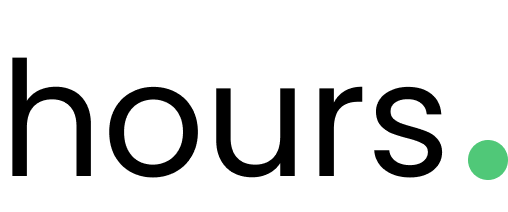
- Virtual study groups are a twist on working with your actual classmates. For example, Hours uses the concepts of gentle social pressure for accountability and the focused attention of having a pre-determined commitment to create a study/work partnership for improved productivity.
- Professionally led groups are another option. A number of professional organizers and productivity experts lead in-person and virtual membership groups to create a collaborative platform for helping members achieve their goals.
HIRE A PROFESSIONAL
As a Certified Professional Organizer, my colleagues and I are, in many ways, professional accountability partners. We provide physical organizing services and share our expertise on organizing and productivity topics, but clients often say that motivational and accountability support is the key to helping them break through the emotional obstacles to getting things done.
The type of accountability you get from a professional organizer might include in-person or virtual body doubling, homework assignments, or phone/email/virtual check-ins, and the type of accountability format will depend on your needs and personal style.
To find a professional organizer who can help you in-person or virtually, use the search functions at NAPO, the Institute for Challenging Disorganization, or Professional Organizers In Canada.
Other professionals you might consider to help you gain accountability might include a:
- business coach
- life coach
- ADD/ADHD coach
- fitness coach or personal trainer
- There are even people who bill themselves as accountability coaches. Although I was unfamiliar with the term, I was intrigued by this provider on Fiverr, who offers three levels of accountability coaching, with goal setting and check-in sessions.
To find a coach or specialist for your needs, you might wish to search the International Coaching Federation.
DOWNLOAD AN APP OR USE A GADGET
If you’re an introvert (or shy), you may prefer to get accountability without face-to-face (in-person or virtual) interaction. If that’s the case, a number of apps and digital solutions can provide accountability, but these are better for longer-term goals than specific tasks or short-term projects.

- StickK – This is an app-based commitment platform designed for those for whom the carrot (a reward) is less effective than the stick; in some circles, this is called loss aversion. Users sign “commitment contracts,” stating the amount of money they’re willing to put on the line to achieve their defined goals (for health, career, exercise, etc.). For example, if you don’t follow through, then the $250 you earmark will be given to a politician or charity you would never support. (If you achieve your goal, you get your money back and may earn some.) StickK’s stakes don’t have to be financial; they can be “reputational,” meaning you might have to publicly say or do something embarassing if you fail to achieve your goal. It’s not everyone’s cup of tea, but it is a bold option.

- Beeminder – The Core Beeminder level is free, gets you three trackable goals, and integrates with a wide variety of apps. There are three premium levels, which earn you an infinite number of trackable goals, customized goals, and options like text-bot responses and real-time support. You can self-report your achievements or connect the app to other apps, like Fitbit, Duolingo, Strava, Apple Health, and Todoist and let them report your achievements directly. This app has aspects of both the carrot (rewards) and the stick (lost challenges).
- Go F***ing Do It – This potty-mouthed (and name/logo-redacted) site lets you challenge yourself or others to commit to a task or project (cook every day, publish your book, etc.) by a specified date and pledge to pay a dollar amount of your choice if you fail to accomplish it. This is definitely more of a stick than a carrot!
- Pavlok – Billing itself as a habit-changing, Bluetooth wristband using tiny electric shocks, I have to be honest, I thought this was an early April Fool’s joke, but it seems to be for real. It tracks steps, activity, and sleep quality, can tell if you’re biting your nails or thinking obsessively about your ex, and uses vibration, sound, and LEDs as behavioral triggers and notifiers. Check out their approach to building good habits and eliminating bad ones via a combined carrot-and-stick approach:
PARTICIPATE IN AN EVENT
A variety of individuals and businesses offer virtual co-working events and platforms that provide group accountability.
- Sign up for an existing accountability event.
For years, I’ve been participating in my colleague Deb Lee‘s periodic Action Day events. A group of us register, join virtually, and announce what we intend to work on. We then mute our microphones, minimize the video (so we can still see if someone is making a silly face), and work.
We seek each other out in the Zoom text chat and meet on-camera for periodic breaks. The experience provides camaraderie and accountability, and Deb’s tech expertise means that if what we’re trying to work on involves a website, computer, or online kerfuffles, Deb will probably be able to save our bacon.

Deb has two upcoming events: Friday, March 12, 2021 (which is almost at capacity) and Friday, March 19, 2021 (which has more available spaces), both from 11 a.m. – 2 p.m. EST. You can register for a no-cost Action Day at her site.
I’ve noticed that specialists in other fields, including digital marketing, authorship and publishing, and design also offer these kinds of events (either for free or with a fee). In addition, many brick-and-mortar co-working spaces are running virtual events of this kind during the pandemic, so check in with the spaces in your community. They may also be referred to as accountability days, design sprints, or use other industry-specific names.
- Create your own accountability event.
Cat Johnson has an excellent blog post entitled 25 Virtual Coworking Ideas for Workspace Communities that might give you some ideas for getting started with an event for you and your friends, members of your mastermind group, or some willing social media almost-strangers.
- Join an online work gym.
I hadn’t heard the expression “work gym” until I began researching the topic, nor had I heard of “procrastination nannies,” but as of the start of the pandemic, virtual co-working for the purpose of conquering procrastination through accountability has become big business. Focusmate, discussed above, has a freemium approach, but there are two major for-profit players in this field:

Caveday originated as an pop-up program at companies and real-world co-working spaces but easily pivoted to the virtual world in 2020. Caveday offers 40-52 minutes-long “sprints” to optimize the brain’s focus capacity, combined with short, energizing breaks led by facilitators. Try a three-hour drop-in experience for $20, or embrace the full-on cave for $39.99/month for unlimited access.

Ultraworking is the pricier option. Ultraworking offers a rolling schedule of 24/7 Zoom sessions, which they call work cycles, so that users don’t have to wait for a pre-scheduled session. The cost is $49//month, billed quarterly.
Whether you prefer a carrot or stick, whether you’d rather work with an individual or a group, whether you select a free option or pay to increase your commitment), I hope you find one or more accountability solutions to help you push through your procrastination and achieve your goals.
If you have an accountability tool or success story not mentioned here, please share in the comments section. And for more to help you be productive, be sure to check back for my next post, Flow and Faux (Accountability): Productivity, Focus, and Alex Trebek.
6 Steps to Ease Your Way Into Organizing the New Year

Happy New Year! Paper Doll knows that the first week of any new year (let alone after the year we’ve just escaped), can be daunting. Instead of weighing you down with homework, how about we set you up for success with some simple strategies that will ease you into a more organized approach to this year? Deal?
START WITH BABY STEPS
When it comes to clutter, it’s not the space it takes up in your house, it’s the dent it puts in your life!
When it comes to clutter, it's not the space it takes up in your house, it's the dent it puts in your life! Share on XIf you’re late every day because you can’t find your keys or your kids can’t find their homework, that’s a much bigger deal than a cluttered guest room closet or piles of old birthday party photos that haven’t been scrapbooked. (Need I explain to younger readers that photos used to be on paper?)
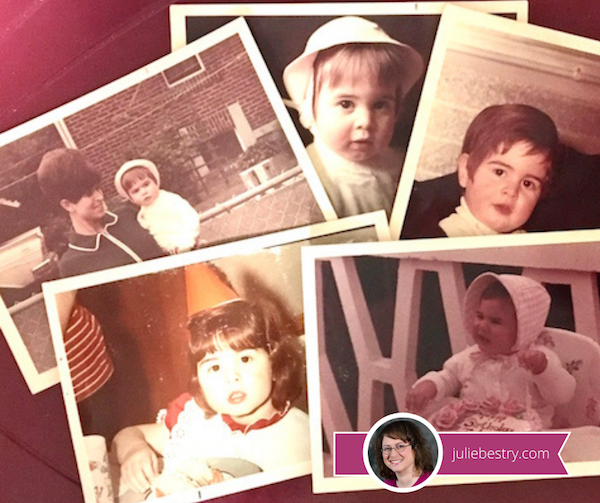
Focus on your biggest daily stressors, break them down into small, actionable steps, and solve those first.
For example, each night after dinner, sort through and declutter one kitchen drawer. When you change for bed, flip through five hangers to see what’s ready to depart. Put a table near the door for the daily launch pad of essential items you need to take with you. Hang a key hook and charging station there and make it a nighttime ritual with your kids to check that everything you’ll need the next day is there.
Don’t even know where to start? Try some of these easy options to organize your finances, your health, and your life – no heavy lifting required:
- Make a tax prep folder. Just grab a folder, label it Tax Prep 2020, and as documents start trickling in this month, you’ll at least have some place to stow them. (Don’t know what to watch for? Read last year’s Paper Doll Says the Tax Man Cometh: Organize Your Tax Forms to get a head start.)
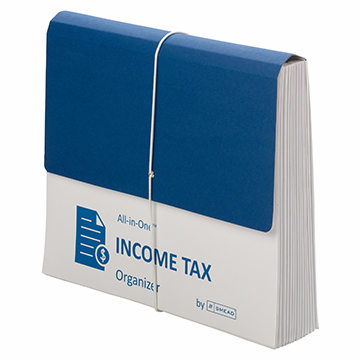
If you want to get a little more advanced, consider Smead’s All-in-One Income Tax Organizer.
- Flip through your new 2021 planner or your digital calendar to see what medical appointments are already scheduled. Make a list of all the doctor’s appointments that you need — family doctor/GP, pediatrician, dentist and orthodontist, ophthalmologist and/or optometrist, OB/GYN, and any specialists, as appropriate.
Check all those appointment cards at the bottom of your bag or thrown in the junk drawer to make sure you’ve scheduled them on your calendar. Then pick up the phone and make all the other appointments now. (Going forward, always schedule your next appointment before you leave their offices. See if you can make one day a week, like Mondays, your “appointment” day so that you’ll get it out of the way early in any week.
- Look through your wallet and VIP files to see what needs to be renewed — driver’s license, car registration, passport, etc. Instead of marking just the expiration date, make notations on your calendar to handle renewals enough in advance so nothing falls through the cracks.
GIVE UP TOLERATING WHAT BRINGS YOU DOWN
Last summer, in Organize Away Frustration: Practice the Only Good Kind of Intolerance, we talked about this at length. Take notice of the things that annoy you, whether it’s a closet too cluttered that you can’t close the door, a light fixture that keeps flickering, or a cable bill that should be renegotiated with a gentle threat to cut the cord. If something doesn’t bring you closer to the life you want to be living, make this the year you let it go. Don’t tolerate what doesn’t delight you.
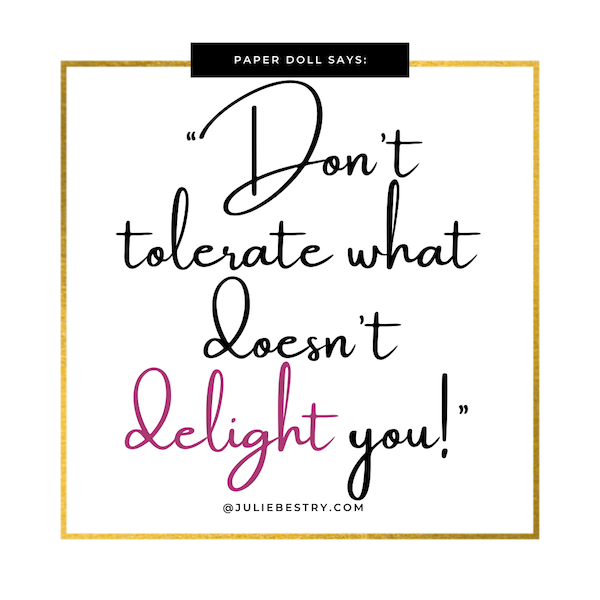
Do a brain dump. Think of a brain dump as mental hygiene, like the cognitive equivalent of brushing your teeth. Ever have the taste of garlic or fish in your mouth after dinner, such that you couldn’t really enjoy your dessert? A brain dump, where you get everything out of your head and onto paper, let’s you stop thinking of things and start thinking about them, in context. Taste your life!
Try to make a list of everything that you know you have to do in order to stop being frustrated. Go room to room and write down what you need to address. (If you’re the kind of person who really needs categories, you can create columns for things that are free or only require your own effort vs. things that require payment.)
Once you have the list, you can start working through what are immediate priorities, what’s worth scheduling, and what can go on the “I’ll do it if I’m so bored it’s between doing this task or watching paint try” list.
Feel free to tackle the tasks in any order you choose, but come up with a plan. Easiest-to-hardest helps you gain confidence; hardest-to-easiest makes everything less stressful because you’ve tackled the most difficult item first. Doing the free tasks first gives you time to budget for the more costly ones, but if you can purchase freedom from a frustration, it’ll release mental energy for other tasks.
STOP USING CLUTTER AS A TO-DO LIST
- Are you keeping a holiday gift on the dining table so you’ll remember to write a thank you note?
- Do you have boxes of donations in the middle of the hall to prompt you deliver them?
- Are you keeping a receipt to remind you to get someone to pay you back for their half of a gift (or to remind yourself to pay them back)?
- Is your unopened electric bill sitting out to remind you to pay it?
- Do you have months’ old email in your inbox hoping that keeping it there will push you to reply?
How’s that working for you? Instead, follow these steps.
- Clear your desk or a space at your kitchen or dining room table to give yourself work space.
- Take five minutes and look around the room you’re in. What do you see that’s out of place because you’re (intentionally or otherwise) using it to prompt you to do something?
- Grab a notebook and for each thing that’s in the wrong place, write down what you should be doing, instead. Yes, this gives you a To Do list that will stare you in the face (but we’ll get to that).
- Put the item away so that it’s no longer clutter.
- DO THE THING!

©2010 Allie Brosh, Hyperbole and a Half, via MemeGenerator
Let’s see how this works. Unpack and put away the holiday gift and go grab a notecard, envelope, return address label and stamp. Put it down on your cleared desk space.
Now, here’s the first tricky part. You can either write out the thank you note right now (check out my Gratitude, Mr. Rogers, and How To Organize A Thank You Note for guidance) and then you won’t use all your mental energy procrastinating about it, or you can put it on your To Do list. If you write the note now, you can put it on your To Do list and check it off your list, all at once, giving you an immediate sense of accomplishment! Whoohoo!
Repeat the process. Carry the donation boxes to your car, then eyeball your calendar to figure out when you can deliver the donations. Schedule the task, delegate it to a family member, or use GiveBackBox to schedule a free pickup.
And again! Use your favorite app, like Zelle, CashApp, Paypal (or ugh, fine, Venmo) to pay or request money and either file or shred the receipt as necessary. Pay the electric bill. Reply to the email or declare bankruptcy on it.
FOLLOW THE ICE CREAM RULE
So maybe your clutter is there because you don’t know where else to put it.
I tell my clients, “Don’t put things down, put them away.” By “away,” we assume you’ve already got a location in mind. Good organizing systems have two parts: the where & the how. If you bring home a bag with three items, ice cream, toilet paper, and breakfast cereal, I’m pretty sure you’re going to put the ice cream away in the freezer first (and immediately) to keep from having a melted, sticky mess. The freezer is the “where” but putting the ice cream away first is the “how.” It’s so innate, you don’t even think about.
Clutter comes from deferring that decision making. With ice cream, you don’t even have to stop and think; it’s instinct built from life-long experience. With everything else entering your home (whether a purchase, a gift, or a freebie), decide on a home before you buy or bring it in. Once it’s in your space, build time into your calendar for how/when you’ll deal with maintaining it or getting it back to where it lives.
Do you bristle at the idea of planning when you’ll do things? Maybe you feel like scheduling things belongs in the category of “budgets” and “diets” — it’s about The Man trying to keep you down!
The thing is, if you’re organized, you probably already have a system and your system feels like a safety net rather than a suffocating obligation. If you’re NOT organized, you’ll just have to trust that a system – a plan, if you will – makes life more organized so you don’t have to keep thinking about these things.
What are the triggers in your system? When will you do laundry: when the laundry basket is full or when it’s Tuesday morning after breakfast? When will you file financial papers? When your in-box is overflowing, or when your computer dings to tell you it’s 11:45a on Wednesday?
Remember: “Someday” is not a day on the calendar. Until something is innate, having an auditory or visual trigger (or both) will help remind you where and when to put things away.
REMEMBER THAT EVERYTHING SHOULD HAVE A HOME…BUT NOT EVERYTHING HAS TO LIVE WITH YOU
Systems are important, but don’t forget a universal truth: not everything you own needs to stay in your orbit forever.
Give what is no longer age-, size-, or lifestyle-appropriate new life via charity or consignment. Let it be a blessing to someone else.
Give what is no longer age-, size-, or lifestyle-appropriate new life via charity or consignment. Let it be a blessing to someone else. Share on XIf it’s broken and you’re not willing to spend the time or money to repair it, let it go. If you have an emotional attachment to something that’s broken, outdated, or takes up too much space to keep, take a photo of you holding it or wearing it. Then set it free!
Setting up a donation station in your home is as easy as putting a box or plastic tub in your utility room, mudroom, or garage. When you’re doing laundry or sorting through toys in the playroom, if it doesn’t fit your life, take it to the donation box right away. When the box is full, log the contents (if you’ll be taking a deduction), and send it to your favorite non-profit. Don’t wait until you have lots of boxes – one box of useful items or clothes, sent on its way, is more useful to others than mountains of boxes that never make it out of your home.
Are your file folders bulging? Do I Have To Keep This Piece of Paper? gives you a clear idea of what you need to keep and for how long. The rest? Shred and send on its way! Buh-bye!
FOLLOW THE BUDDY SYSTEM
Getting your space, time, and priorities in order can be overwhelming, but you don’t have to go it alone. For accountability and support in reaching your organizing goals, buddy up with:
- Your spouse – Trade the chore you hate (unloading the dishwasher) for the one that annoys your spouse (folding laundry) and you’re each less likely to procrastinate.
- Your kids – Make organizing a game – play Beat the Clock with your kids to see who can collect the most things that don’t belong in the living room before the song ends, and then work together to put the items away.
- Friends – Make organizing social, even when you can’t get together. Text “fashion show” photos or do a Zoom call as you organize your closets. (Friend-of-the-blog Nancy Haworth of OnTask Organizing and I did this last week! I got rid of big-shoulder-pad 80s-style blazers and she jettisoned clothes that pre-dated her strong, lithe, “certified exercise instructor” shoulders!)
- A professional organizer – As a Certified Professional Organizer®, I know how much my clients get out of having someone who knows the ropes guide them in making solid decisions and developing systems to surmount those challenging obstacles. Find a professional organizer near you by using the search function for the National Association of Productivity and Organizing Professionals (NAPO).

Speaking of which, it’s January, so that means it’s GO (Get Organized and Be Productive) Month! It’s the perfect time to focus on making your life run the way you want it to. Happy New Year, Happy GO Month, and just plain…be happy!
Paper Doll Wraps Up, Declutters, and Updates 2020

It’s been quite the year. “Unprecedented,” you might say. (Or, better yet, let’s not say. How about we purge that word from our vocabulary?) Before we turn the calendar page to 2021, there are a few additions and updates for the posts you read (or might have missed) over the past year.
PANDEMIC PRODUCTIVITY
The Now Normal: When the New Normal Changes Quickly
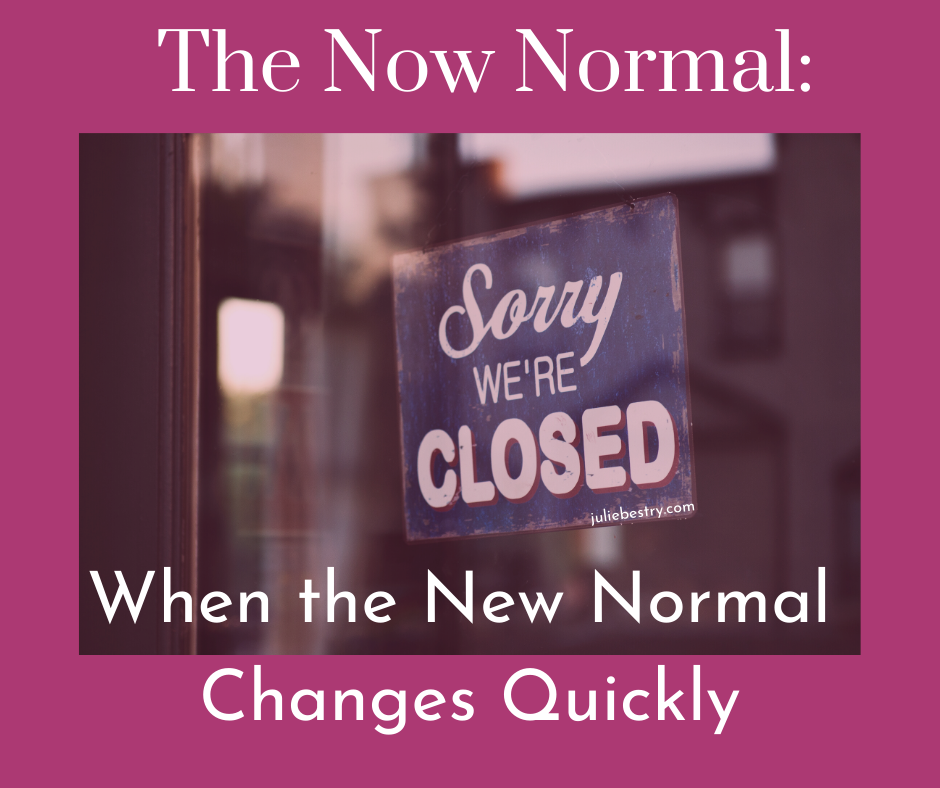
Back in March, none of us knew what the next nine months would bring. I’d acknowledged the difficulty of being at home, whether that meant working from home, home-schooling, or dealing with family and their foibles 24/7, and noted that at least, to some extent, we’d get used to it, or at least we’d have to get used to the “Now Normal” of things constantly changing and us not getting used to things. Little did we know how long (how very, very long) we’d be getting used to things constantly changing. I gave you all permission (as much as anyone needs permission from random internet bloggers) to be OK with not being OK.
Now, on the cusp of 2021, there’s light (in the form of a vaccine) at the end of this tunnel. But I suspect things will never go back to exactly where they were. Remote work had already been increasing (by 173% between 2005 and 2018); 2020 gave companies the impetus to make this a more permanent option. Companies that had believed workers could never be as productive when working remotely found that the opposite was true. According to research collated by Apollo Technical:
- Performance can improve up to 13% when working remotely (in a quieter, more convenient workspaces)
- Remote work yielded greater worker satisfaction
- Remote workers spend 15% less time avoiding work tasks
- Anecdotally, once supervisors trust the work-from-home approach and stop micromanaging, productivity increases.
This doesn’t mean we can extrapolate only good things to come out of more people working from home. Even once children and life partners are no longer in the home/work space, the distractions of household tasks (especially for women) will likely adversely impact productivity, and research indicates that productivity may take a hit due to prolonged lack of social interaction (especially for extroverts, like moi).
Some workplaces will stay 100% remote; others will return to traditional venues; and I suspect many employees will demand greater flexibility, and companies will want to consider the reduced overhead associated with smaller (or no) dedicated offices. The only thing we know for sure is that things will continue to change, and we’ll have to be nimble, accepting that the sand will keep shifting under our feet. As L.P. Hartley once wrote, “The past is a foreign country; they do things differently there.”
The only thing we know for sure is that things will continue to change...As L.P. Hartley wrote, 'The past is a foreign country; they do things differently there.' Share on XPaper Doll’s Ultimate Guide to Organizing a Virtual Field Trip

This post proved to be one of the most popular during the early pandemic. Organizing our days to include breaks, including virtual day trips to escape monotony, became a necessity this year, and rarely a week went by when a reader did not email or tweet or post to tell me about other cool virtual field trips.
Friend of the blog Janet Barclay knows that Paper Doll is a consummate Jane Austen fan, and forwarded Celebrate Jane Austen’s Birthday With a 360-Degree, Interactive Tour of Her House, and from there it was a quick hop, skip, and virtual jump to the Emma Thompson-narrated Twelve Days of Christmas special. There are also paid live virtual tours of Jane Austen’s House from Home, trails, and exhibitions. (Two live tours in January each go for £5, or about $6.78).

Discovery Education has developed a variety of live and on-demand, family-friendly interactive field trips. Each is free and includes a companion guide with hands-on learning activities! Take your kids to “visit” the Johnson Space Museum in Houston, see the cars of the future, hobnob with polar bears in the Tundra, and so much more. Whether you need a virtual field trip to break up winter vacation, quell home-schooling doldrums, or reverse just too little play time, Discover Education is a delightful addition to the options in my post.
Perhaps you binged too much of The Crown and need a reality check? Take a virtual tour of Buckingham Palace. Prefer a different venue? How about the Taj Mahal, the White House, or the Vatican?
Virtual Museums started an interactive map of the world’s museums available to virtual visitors. (Create an account to track and rate your visits.) From the Canadian Museum of Human Rights to South Korea’s National Museum of Modern and Contemporary Art to the mysterious fossils of the Graz Natural History Museum in Austria, new field trips for grownups are appearing all the time.
And if you need the the kind of field trip that takes you away from the hubbub, Escapista may be to your liking. Escapista has developed a manifesto to explain its approach to selecting opportunities for immersive meditative experiences, from pausing by a snowy river to Norway’s “Slow TV” experience of ten hours on a train. (Click the speaker icon to turn on the audio.)
Be sure to organize time in your life to relax and to learn for fun.
Does Anybody Really Know What Time It Is? 5 Strategies to Cope With Pandemic Time Dilation
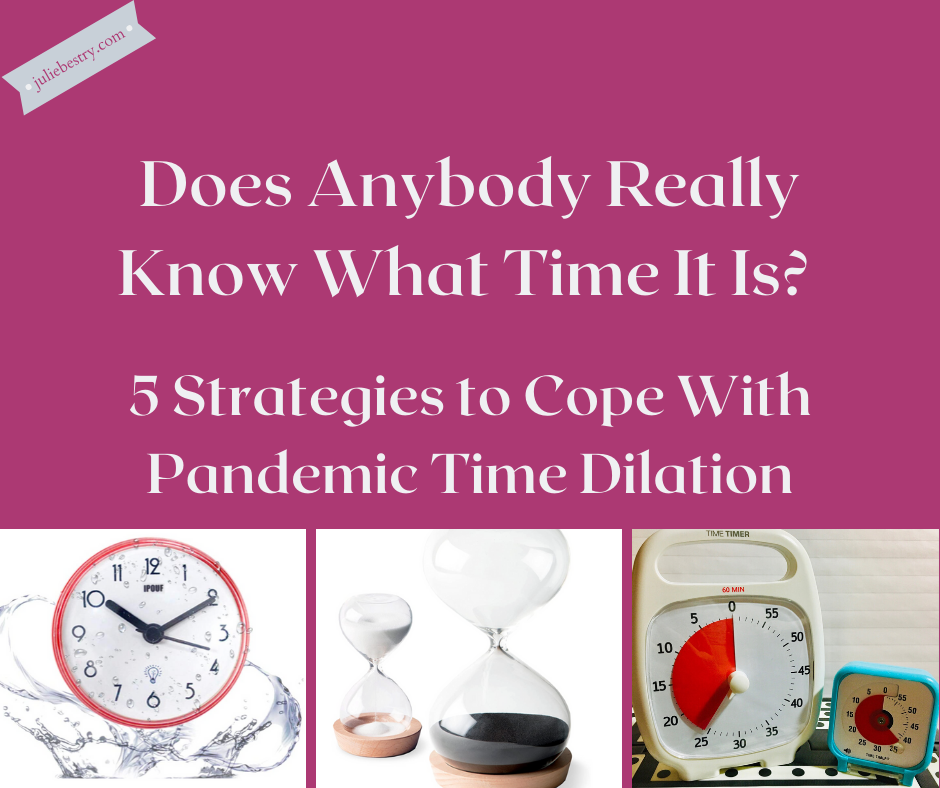
There’s an irony of mentioning time dilation between two long weekends marked by Christmas and the new year. I’ve lost count of how many people have told me they checked for the mail on Friday or took the trash to the curb on the wrong day.
In the original post, I explained why our body clocks became so borked during our quarantine and recommended five strategies, with LOTS of tactical suggestions, for keeping everyone from becoming unstuck in time:
- Put structure in your life.
- Enhance novelty.
- Create vivid sensory clues for the passing of time!
- Get what you know you need! (Daylight, sleep, exercise, and for those of you who’ve had the same pair of sweats in rotation since St. Patrick’s Day, get dressed!)
- Take a technology break.
As a professional organizer and productivity coach, my job is to help people get more out of their time. But efficiency isn’t everything. In a year like we’ve had, and going forward, some daydreaming and navel-gazing preserves sanity. If you find yourself losing track of time too often, add in a bit of structure to your day and use technology to get a quick “beep-boop.” But do give yourself permission to enjoy the one small benefit of this year, living by your natural body clock.
Organize Your Health: Parental Wisdom, Innovation, and the New Time Timer® Wash
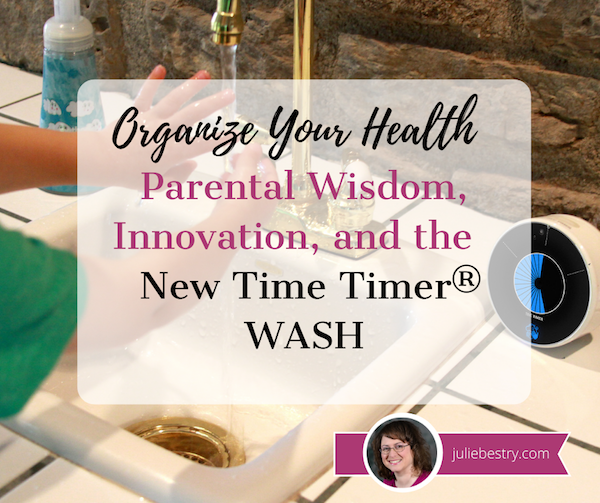
Don’t touch your face. Wear a mask. Wash your hands. It’s good advice, so listen to your mom. Listen to mine.
READING RENEWAL
12 Ways to Organize Your Life to Read More — Part 1 (When, Where, What, With Whom)
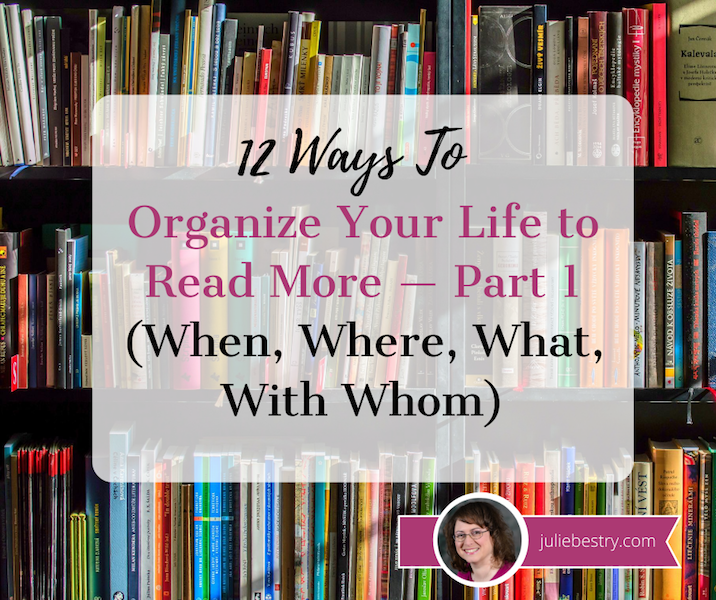
I’m not the only embracing tips for reading more. Oprah, the ultimate book club leader, may have ended her print magazine, but the December issue offered up 20 Simple Ways to Read More and Enjoy More Books in 2021. (Personally, though, I preferred my take on developing a reading nook. What do you think, readers?)
12 Ways to Organize Your Life to Read More — Part 2 (Reading Lists, Challenges & Ice Cream Samples)

Want to read more in 2021? You’ve got a bounty of options for finding recommended reading lists. One of my favorites is the NPR Book Concierge. (Find annual suggestions going back to 2013.)
If, instead of looking for a specific title, you want to find a 2021 reading challenge that, well, challenges you, opportunities abound, including:
The Uncorked Librarian (Most intriguing suggestion: read a book set on a train.)
Modern Mrs. Darcy (This year, it’s not just reading prompts, but an entire interactive kit for creating your personalized reading life!)
GirlXOXO Master List of Reading Challenges (While I’ll skip the challenge to read mysteries with cats as main characters, there are certainly lists galore for every taste!)
Meanwhile, who would be up for a Paper Doll reading challenge to embrace books on organizing and productivity?
How To Make Your Reading Time More Productive With Book Summaries
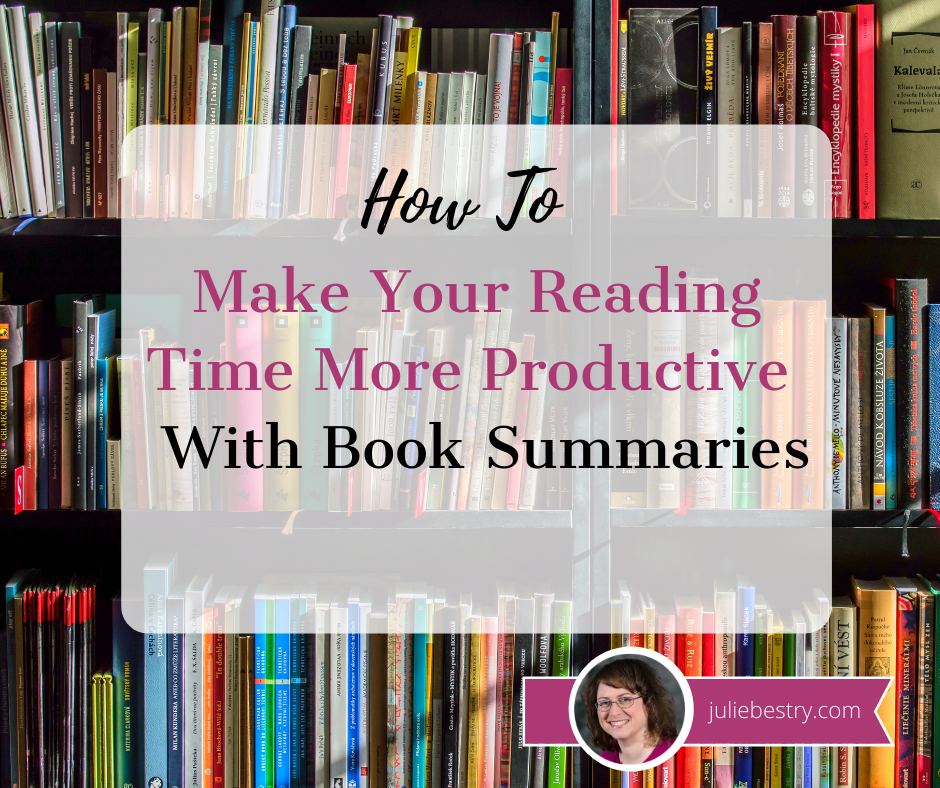
My coverage of book summaries focused on non-fiction. Unless you’re in 11th grade English class (sorry, kids), you probably don’t want summaries of novels. However, you can get ice cream tastes of fiction, to see if you like an author’s style.
- Most people are familiar with Amazon’s “Look Inside” feature, which allows you to click a link above the book cover and read a handful of pages. But did you know that many Kindle books have “Send a free sample” link so you can preview chapters? Check in the browser version, not the app, below the “purchase with one click” section and above the “add to list” button.
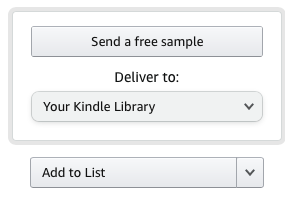
- You can also get a free audio sample. Check for a link under the book cover.
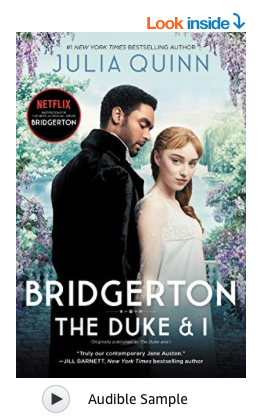
- Literary Hub has daily offerings of novel excerpts. Click on the book cover you want to try, and the resulting page provides short author bio and a selection from the novel. Titles range from new releases, like Mrs. Murakami’s Garden, to reprints of classics, like Betty Smith’s Tomorrow Will Be Better. (Literary Hub also has short stories excerpted from short story collections.)
PAPERWORK DECLUTTERED
Organize for an Accident: Don’t Crash Your Car Insurance Paperwork

In April and May, due to much of the country quarantining and people driving far fewer miles, many insurance companies offered 15%-25% premium rebates to customers.
While rebates largely disappeared by June, that doesn’t mean you should be paying full price if you’re still staying close to home. For example, if your workplace has decided to go “permanently remote,” and you no longer have a commute, it’s worth contacting your insurance agent about potentially lowing your premiums now that you are regularly driving less each week. One option insurance companies are exploring is vehicle telematics, little “black boxes” that keep track of your speed, mileage, and precision at accelerating and decelerating, and report back to the insurance company. Safer drivers get better rates.
Similarly, if your college-age student is not currently on campus and is attending school remotely (from your home), that means your car is in the driveway most of the time, not states or time zones away. Review your situation with your agent for the greatest number of discounts.
Paper Doll On Narwhals, Fake News, and How To Get A REAL ID

Everything in the post is still accurate except for the enforcement deadline. Due to COVID, the federal government delayed enforcing REAL ID by one year, to October 1, 2021. Remember, as of next October, if you don’t have Real ID-compliant identfication, you won’t be able to board a domestic flight or enter federal courthouses or restricted federal facilities, like military bases, nuclear power plants, or the White House.
Paper Doll Says The Tax Man Cometh: Organize Your Tax Forms

The forms are the same, but a few the rules have changed. Kiplinger’s Magazine covers a few dozen of the Tax Changes and Key Amounts for the 2020 Tax Year.
ORGANIZING ADVICE, PLAIN AND SIMPLE
The Truth About Celebrity Organizers, Magic Wands, and the Reality of Professional Organizing
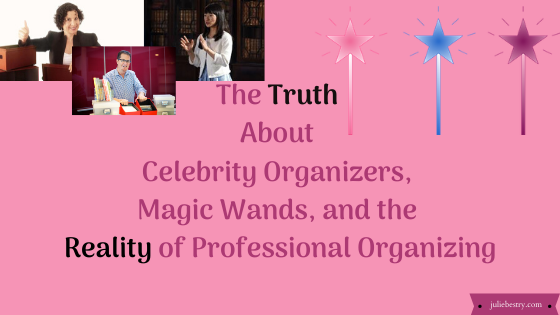
As you head into 2021 armed with resolutions to get more organized, please review my counsel in this post. I stand by my word that there are no magic wands!
And in a future post, I’ll have more to say about advice from celebrity organizers with regard to organizing by color. Here’s a preview:

(Readers, if you like curry in your pumpkin pie, feel free to tell Jacki directly!)
Organize Away Frustration: Practice The Only Good Kind of “Intolerance”
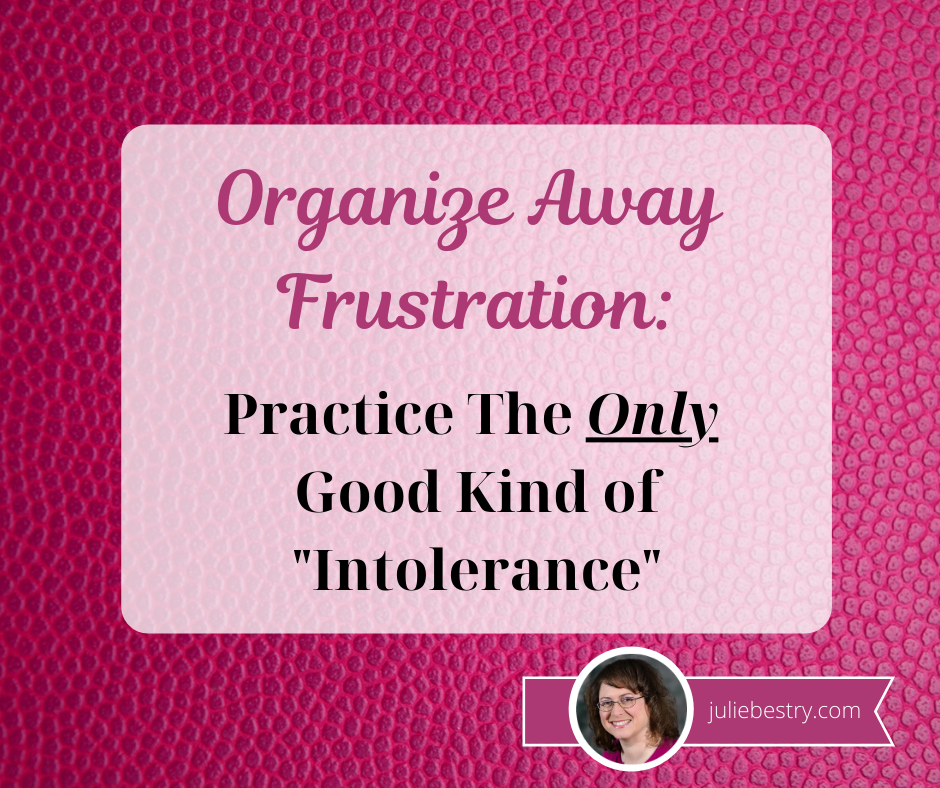
This is the perfect week for you to take note of whatever frustrated you during the holiday season: a light system with too many broken bulbs, an artificial tree that has seen better days, a sense of obligation to send holiday cards to people who haven’t so much as liked one of your Facebook posts in a decade. Stop tolerating what doesn’t work for you, and if you don’t know the solution, seek help to find one.
Paper Doll Peeks Behind the Curtain with Superstar Coach, Author & Speaker Leslie Josel
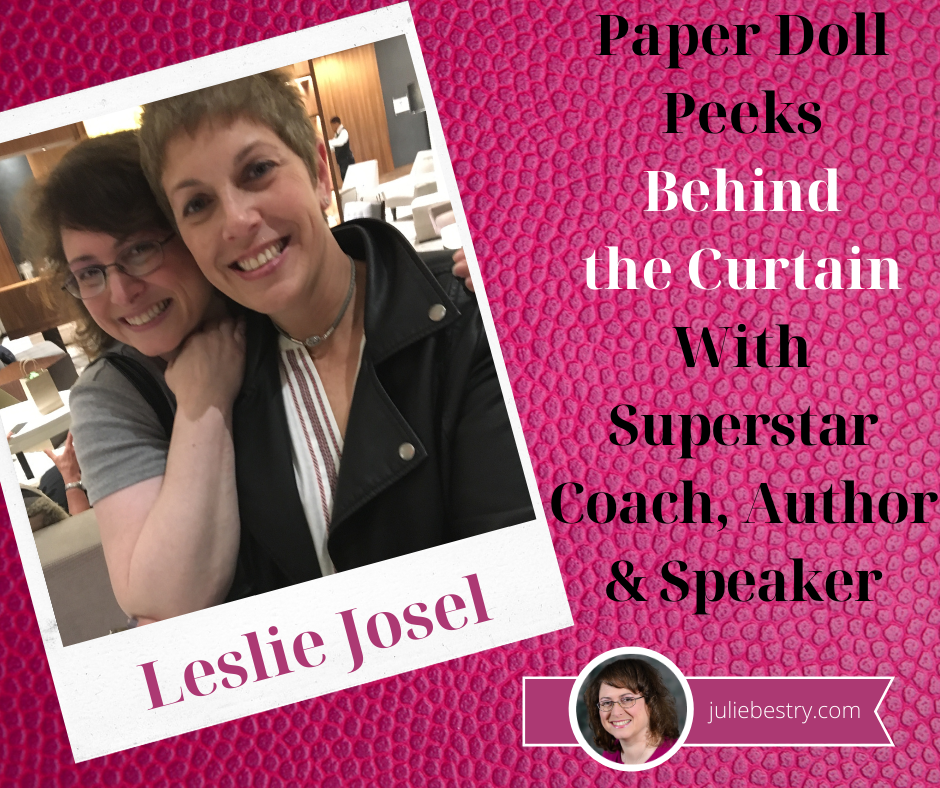
Our talk about 1980s sweaters may have been dated, but discussion of student procrastination is not. This fall was the first semester that was 100% in COVID times; even stellar students struggled, and “taking an incomplete” has become a common refrain. If you have (or are) a student, Leslie’s How To Do It Now, Because It’s Not Going Away should be on your bookshelf.
Organizing in Retrospect: A Confessional Look Back at 2020

Writing this post, I realized I accomplished more than I realized. (Which would have been easy; when people asked what I’d been doing this year, I was often at a loss for words. “Missing my mom, my friends, and my travel plans, eating too much cheese, and craving Chinese food” seemed like an ineffective response.
This quiet lull before the new year is the perfect time to pull out your calendar and scan your To Do lists. Take notice of your achievements; in a year like this, it’s easy to forget small (and even not-so-small) victories. Ask your friends and loved ones to report back on the successes they recall from your year. Tally them up. Whether you use this in your next performance evaluation at work or just to buck up your self-esteem, remember that surviving this year intact is an accomplishment!
CLUTTER-FREE HOLIDAY GIFTS
In a Downton Abbey-themed post a few years ago, I told you about Give Back Box, a program whereby you could gather up the items your new holiday presents made redundant and easily ship them off to charity. This year, especially, when a touch-free donation option is especially useful, I encourage you to explore Give Back Box.
Clutter-Free Holiday Gifts for the Weird Year of 2020 (Part 1): New Twists on Old Favorites

For those of you looking for gifts of cooking classes, two highly praised options came in after deadline: King Arthur Baking‘s impressive calendar of interactive, online cooking and baking classes, and Milk Street‘s live-streamed and recorded, self-paced virtual classes. (If you give a cooking class gift to someone with whom you live, you get to eat the homework!)
Clutter-Free Holiday Gifts for the Weird Year of 2020 (Part 2): Giving Well, Giving Back

In addition to tangible gifts that give back to others, I wrote about charitable giving in your recipient’s name. Due to COVID, new tax laws let most taxpayers deduct cash donations of up to $300 made by December 31, 2020 when filing taxes in 2021 – even if you don’t itemize. (Note, this is a “per return” deduction, meaning married couples get the same $300 deduction as singletons. Consult your tax advisor.)
Clutter-Free Holiday Gifts for the Weird Year of 2020 (Part 3): Organizing Yourself & Others

Finally, I hope one of the gifts you give yourself is the time and opportunity to keep reading organizing and productivity advice here at Paper Doll.
Thank you, my dear readers, and have a happy, healthy 2021!
Organizing in Retrospect: A Confessional Look Back at 2020

I can’t imagine that 2020 was anyone’s favorite year. A global pandemic, a contentious election cycle, civil upheaval undergirding fights for justice, and unpredictable macro- and micro-economies were not on anyone’s wish list. Indeed, even the idea of a wish list seems preposterous now, as Robyn Schall explains:
This has absolutely finished me off I love her pic.twitter.com/6DaI0gxDEe
— wap rem x (@jackremmington) November 15, 2020
The year had other dashed hopes, disappointments, and dark moments. The National Association of Productivity and Organizing Professionals had to cancel April’s annual conference with only a few weeks’ advanced warning. A “girls’ getaway” to Ireland vanished. My inspiration to write disappeared as well, as writer’s block was my sole visitor in 2020.
Certainly the worst of all, Paper Mommy fractured two vertebrae just a few weeks into quarantine, leading to months of agony. I miss my mom, I miss my clients, I miss seeing people’s smiles. If anyone asks, tell them Paper Doll says this year has been yucky.
I miss my mom, I miss my clients, I miss seeing people's smiles. If anyone asks, tell them Paper Doll says this year has been yucky. Share on XIS HINDSIGHT 20/20 IN 2020?
Many of us in the productivity realm encourage our clients to pick a word or phrase for the coming year to help guide our mission. I’ll admit, I’m as guilty of magical thinking as the next person. I had feared that “Abundance” could bring an abundance of negative things. In retrospect, then, my choice of “Ample” seems almost absurd. (I’d even developed a funny social media tagline. “Ample: It’s not just for bosoms anymore!”) This year had an ample supply of absurdities.
Being a professional organizer and productivity specialist involves working from a position of positivity. Indeed, as we approach Thanksgiving, we’re all supposed to focus on gratitude, on the experiences and people who made the prior year worthwhile.
I’m sure I’m not the only one who has been finding it hard to reflect on this year and find positivity. Maybe it’s the same for you?
Some years seem best dealt with by offering a Viking funeral. “Set 2020 aflame and put it out to sea,” I often thought as March 243rd dragged on. However, my accountability partner and awesome colleague Dr. Melissa Gratias recently wrote a post called Taking Inventory of 2020 with Duct Tape, Henry the VIII, and Forrest Gump that put her own year in perspective. For her, this was an exercise in silencing her inner critic.
Read Melissa’s post, then come back and sing some Herman’s Hermits before you spend the next 5 weeks hearing nothing but Jingle Bells and Rudolf the Red-Nosed Reindeer.
We’re often quick to criticize ourselves for all that we did not get done; this is even more true in 2020. I touched on this in my favorite post that I wrote this year, The Now Normal: When the New Normal Changes Quickly. There, I said simply that “It’s OK to not be OK.” It’s OK if you’ve had eight months at home with no commute and you still haven’t written the Great American Novel or downsized your closet into a capsule wardrobe.
Similarly, Melissa reminds readers in her post that our days, our years, and our lives are not merely the lowlights and highlights, but the a rich tapestry of everything that happened. To that, Paper Mommy would add that it’s important to consider all the things that didn’t happen, but not in a “my trip got canceled” way. In response to the question, “Tell me something good that happened today,” Paper Mommy has been known to respond, “Well, nothing bad happened today.” She’s not damning with faint praise. That’s her brand of positivity.
In response to, 'Tell me something good that happened today,' @PaperMommy has been known to respond, 'Well, nothing bad happened today.' She's not damning with faint praise. That's her brand of positivity. Share on X
So, to echo Melissa’s efforts, I thought I’d share some of my activities. (That said, my inner critic cuts me a lot more slack than hers. I’m just amazed we’ve made it to Thanksgiving week!)
TALKING (LITERALLY) ABOUT ORGANIZING AND PRODUCTIVITY
For much of this year, I’ve been unable to visit with my clients. I’ve touched base by phone and email, making sure they’re healthy and supported, and I’ve added virtual organizing and productivity services to my offerings. But the main way I’ve been able to share my thoughts has been via the internet.
Ray Sidney-Smith is a productivity/technology/management triple-threat consultant and trainer. I met him when we trained together as Evernote Certified Consultants, and he has become a bigwig in this area. In October, he asked me to be a panelist on the Anything But Idle podcast he hosts with Augusto Pinaud, bilingual productivity coach and all-around sweetie. Here’s the video, but you can listen at the episode page and subscribe via the links on the sidebar. Don’t be too surprised when I geek-out about paper planners.
Although my Halloween costume as a Work-From-Home solopreneur wasn’t quite as creative as Ray’s or Augusto’s, you won’t doubt my enthusiasm. Plus, my co-panelist was Penny Zenker, Focusologist, motivational speaker, and (Halloween) pirate. Thanks to meeting her on the Ray and Augusto’s show, I’ve now been a guest on two upcoming episodes of Penny’s Take Back Time podcast. (Watch this space for official scheduling.)
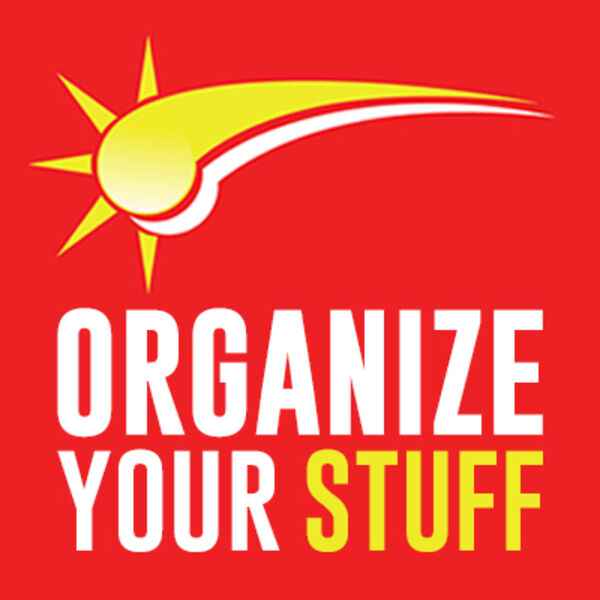
Earlier in the year, I was also guest on Maria White‘s Organize Your Stuff podcast, where Maria and I had a long talk about one of my favorite paper organizing topics, tickler files. (You do know about my ebook, Tickle Yourself Organized, right?)

Listen to my episode on Maria’s show here, and be sure to subscribe in Apple Podcasts, Stitcher, Spotify, or wherever you get your juicy podcast goodness.
WRITING ABOUT ORGANIZING AND PRODUCTIVITY
As I mentioned, I had a pretty severe case of writer’s block this year. Or, actually, multiple cases, as it tended to come and go. Thus, I did not write the second edition of my first book, or the first edition of my second book.
However, when I was asked by others to write guest posts, ghostwrite, or contribute advice, I did manage to shoo the writer’s block away. Often, what I was asked to write was about organizing things other than paper, which helped clear the cobwebs. For example:
I wrote about how to keep kitchen pantries clean and organized in Home Organization: Tips from Professional Organizers for Porch.com.
When Redfin asked me to talk about how to tame the chaos in your child’s room for How to Get Your House in Order without Buying Anything New, I wrote more than they could fit, and now I’ve got a chapter for a book I hadn’t even anticipate writing when the pandemic began.
For Realtor.com, I held forth on 4 Types of Clutter: How Many Are You Hanging Onto?, including sentimental clutter, painful clutter, “sunk cost fallacy” clutter, and all that clutter related to one’s self-image.
And I was especially proud to have my advice appear in four different issues of Real Simple Magazine this year in pieces penned by Leslie Corona. If you’re a subscriber or picked these issues up on the newsstand, or if your public library is offering holds on magazines, you can find these articles in your print issues:
Organizing Challenge: Stow Your Purses and Totes in the February 2020 issue, pages 52-53, also appears in truncated form online as 3 Smart Ways to Keep Your Handbags and Totes Organized. Researching this topic was so much fun, it inspired me to write Organized Purses? It’s In the Bag!

For Real Simple’s big May 2020 “Get It Done” section, I contributed to Get it Done: Refresh Your Medicine Cabinet, page 58. Though the advice pre-dated COVID, it ended up being timely.

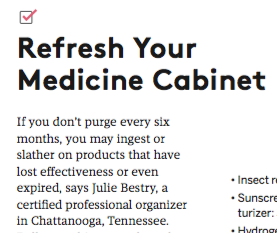
The most involved Real Simple piece was Your Road Map to a Tidy Garage, found on pages 58-60 in the October 2020 issue, and I was delighted to be tagged as a Real Simple “expert” along with NAPO colleagues Scott Roewer and Lisa Zaslow!
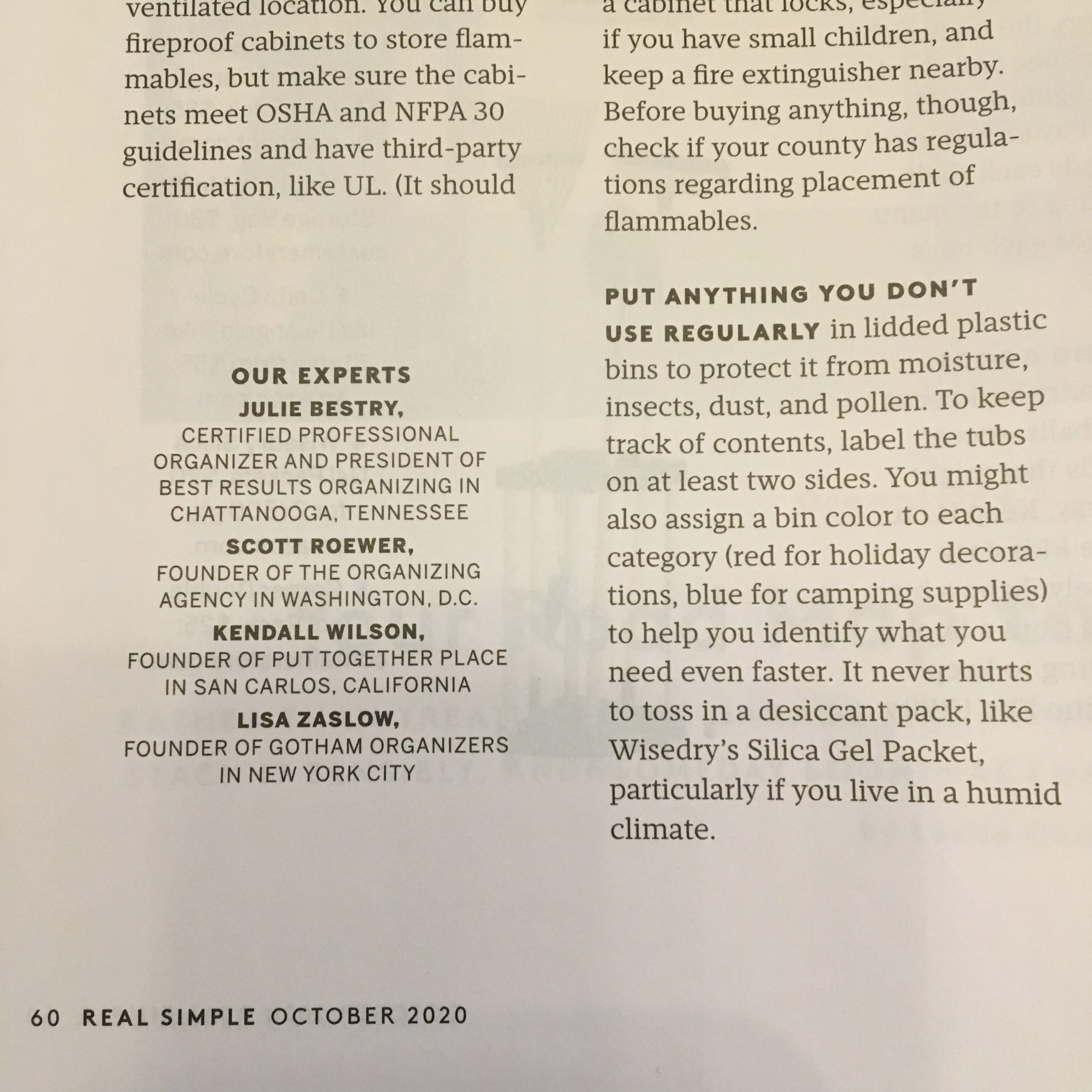
Long before the pandemic, Real Simple had asked me to weigh in on advice and products for organizing technology for travel. Travel soon became a hazily recalled habit of the past, like visiting malt shops or riding street cars, and that article never saw the light of day. Happily, a bit of the advice found new life as November 2020’s Organizing Challenge: Down to the Wires on page 50.
HELPING SOMEONE ELSE BE PRODUCTIVE
As I mentioned at the end of The Now Normal post, one of the things I did after lockdown began was edit Melissa Gratias’ book, Captain Corona and the 19 COVID Warriors. My role was small (Melissa is already a great writer) but satisfying, especially as the book took off. First local newspapers picked up the story, then People Magazine. A smile still spreads across my face when I hear Akil Jackson narrate Captain Corona.
And finally, even with writer’s block refusing to pack its bag and go, I feel really good about the blog posts I wrote this year, whether I was sharing advice for getting through a global pandemic or guidance for organizing time to read, or eliminating “tolerations” by using a shower curtain hook shaped like Marlo Thomas in That Girl.
LEARNING A LITTLE SOMETHING
In March, nobody could have imagined how much of our time would be spent tucked away at home, but I did anticipate that client work would be delayed for at least a few months. At first, my enthusiasm for continuing education was boundless, and I took a wide variety of NAPO courses and independent classes on:
Productivity — Oh my goodness, there were so many classes on productivity systems and tools, including the Getting Things Done rubric and using Evernote. (I watched so many webinars presented by my genius colleagues Stacey Harmon and the aforementioned Ray Sidney-Smith!)
Special topics in organizing — Like most of America, I found myself locked in multiple Zoom rooms a day. I took live classes like Color and Space Planning In Organizing: Personality, Autism, and ADHD, and Making Your Memorabilia Meaningful, and watched recordings of classes I’d abandoned live when technology failures amped up my stress level. (Was any sentence used more often than “You’re on mute!” this year?)
Higher Self coursework — I watched a recording of a NAPO University class called Bringing Meditation and Mindfulness Into Organizing and Productivity. By this point, probably late May, around the time I should have been in Ireland, my patience for Zoom coursework reached a low ebb. I was failing at being at all meditative or mindful! Hence, like Melissa (and half of the people I know), I took the exceptional (and free) Yale course, The Science of Well-Being, reinvigorating a passion for learning positive psychology (if not an interest in meditation).
Personal development — Although I’ve been studying Italian through Duolingo for two and a half years, by the time the pandemic started, I’d fallen into the habit of practicing all the lessons that came before everything got really hard.
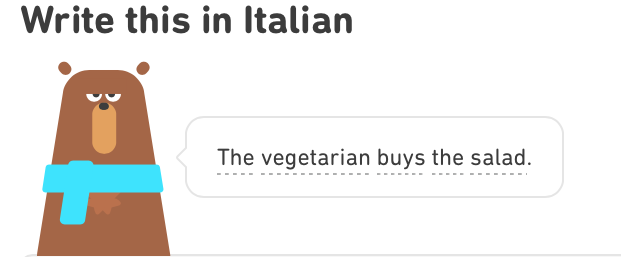
Let’s just say, it was more fun translating “Non puoi finché non finisci la cena” (i.e., “You can’t until you finish your dinner” and “La mia scimmia mangia perché ha fame” (i.e., “My monkey eats because he is hungry”) than it was to push myself into learning the present perfect and past imperfect tenses.
I realized that even though people were quoting The Now Normal back to me, my embrace of “now” didn’t have to mean I only spoke in the present tense!
I also became a little paranoid as Duolingo started feeding me sentences that hit a little too close to home:
- Noi mangiamo molti tipi di formaggio. (We eat many types of cheese.)
- Ho una cucina; però non cucino. (I have a kitchen; however, I don’t cook.)
- Io mangio il formaggio fritto. (I eat fried cheese.)
When you stop interacting with actual people, it feels a little sad when your language learning app knows you so well.
GIVING CREDIT WHERE IT’S DUE
There’s still a little more than a month of this year. I don’t know whether to expect sea monsters or fireworks. I still believe that “It’s OK to not be OK,” and think we all deserve credit for making it this far. If you’re having trouble remembering your accomplishments, ask a friend or two. Chances are that they’re much more observant – and less critical – than your (or Melissa’s) inner critic.
Finally, just in case Melissa’s discussion of Ghost and my clip of Herman’s Hermits wasn’t enough, no reference to “I’m Henry VIII, I am” is complete without this rendition from The Patty Duke Show, the best darn program about identical cousins ever made!
Until next time, I wish you a happy, healthy, and safe Thanksgiving.
Paper Doll Peeks Behind the Curtain with Superstar Coach, Author & Speaker Leslie Josel

Today, we’re talking with friend of the blog, Leslie Josel. You may already know Leslie from her business, Order Out of Chaos, and her various adventures in productivity. Her newest book was released this month. In this post, we’re going to peek behind the curtain on this multi-talented expert on ADHD, student procrastination, and getting everyone around to her to sit up and take notice of what she has to say.
Leslie, we met almost a decade ago at a NAPO conference, but we almost met at college. You and I missed each other at Cornell University by just a few months in the 1980s, the decade of big hair and oversized Firenza sweaters. Could you tell Paper Doll readers about your early life, college years, and the start of your professional life? How did they prepare you for a career as a professional organizer and ADHD productivity coach, as well as inventor, speaker, and published author?

I so wish we had met met at Cornell! That would have been fun. To save your readers from a long story, I’ll share this. I was a Human Development & Family Studies major. And not until I started my business did I pull all that old learning out of my brain. Trust me, it had laid dormant for many years. And I really believe it’s why I focused my business initially on the chronically disorganized, hoarding population, and of course, ADHD families.
For me, I was less about organizing and more about the human dynamics of it all. And if I’m being completely honest, I never really liked “organizing” and if I’m being really honest, I wasn’t that good at it. I was much better at helping individuals understand the root of their pain and things like that. Which in hindsight makes sense of why I stopped “organizing” years ago and went the way of coaching. And when I was a sophomore, I was required to take a public speaking class. It was like the mother ship calling me home. I LOVED it! I liked engaging on that level. And I guess I was pretty good at it since the professor asked me to TA the class the following semester.
And one other fun fact. My mom died when I was very young — ok, that’s not the fun fact. But my dad really raised me as a single dad. And he used to say to me ALL the time, “If you can write and you can speak in front of a group of people, then you can do anything.” Probably that was more true back then, but it definitely focused me. I always wrote in every job I ever had, now that I think about it. I was a speech writer for the head of an entertainment company. I was a publicist right out of school and I was ALWAYS the one given the writing assignments. It was just a natural outlet for me.
What would you say was the turning point that helped you identify your true calling and fine-tune what you do?
So, organizing is not really my true calling. But it helped me get to where I am today. Organizing was a way to have calm in a life growing up that was anything but. My mom was terminally ill my whole life so things in my life and home were out of control. Systems and lists spoke to me. It was always what did best. Give me the big project and I loved it. Keeping on top of all the moving parts was like a big puzzle for me.
But it wasn’t until my son was 5 that my true calling was presented. He was diagnosed with ADHD, and you need to remember there wasn’t anything out there like there is now. There was no “internet,” no magazines or conferences, things like that. I had to rely on my own instincts and gut to figure out how to untangle his world.
You can read my whole story on my site, but I redid my whole house top to bottom so he could function and thrive at his best. A friend saw what I did, sent me to a patient of hers, and two weeks later I got four calls asking me to come do what I did in their homes. I turned to my hubby and said, I don’t do this for a living and he said, “You do now!” And that’s how I got started. Going house to house by myself working with families to set up systems and structures to help their children with ADHD. Remember, organizing wasn’t a whole thing yet — this was 2004 — and organizing ADHD even less so.

© 2020 Order Out of Chaos
Now 17 years later, I’m an academic/life coach for teens and college students with ADHD and LD [learning disabilities]. And my son is 22. So you might say Order Out Out of Chaos and Eli have grown up together. But becoming a coach for both kids and parents was the missing piece to my “journey.” It allowed me to make my business virtual, serve a global audience with a wide range of products and programs, and connect with those that need the most help.
So if I were to say what the turning point was for me — it would be two things. Becoming a coach and turning my business into a virtual one. Life changing.
Until recently, you were probably best-known for inventing the multi-award-winning Academic Planner: A Tool for Time Management. Congratulations on winning the 2020 Family Choice Award, honoring the best products for children and families, by the way. How did your stardom as an inventor come to fruition?
Seriously, Julie? There is no stardom when it comes to inventing planners! Trust me when I say I don’t have a superpower when it comes to this. In fact, fun fact #2, I’m actually very conservative when it comes to my business. So inventing the planner was born out of a frustration and a need. And I think most of you can understand that. How many times have you said, “I wish there was a…” to solve whatever problem you had?
Leslie Josel tells Paper Doll, 'There is nothing sexy about inventing a planner!' Share on XSo there is nothing sexy about inventing a planner! I couldn’t find what I needed to teach kids “how” to see their time. And that’s a biggie when working with kids. So I ordered every planner that was on the market back then and put them all in my basement! I should have taken a picture! And the sad thing was they were all pretty sh***y when it came to giving students what they needed. So I started cutting from one, pasting to another. You get the drift. Then I had my assistant at the time (who had a graphic design background) make a prototype, then ran some off at the local copy shop and gave them to my local clients. And friends started calling…and then friends of friends. So I went back, made some tweaks and made some more. And it kept going!
The one very smart thing I did at the very beginning — OK, here’s Fun Fact #3 — is send them to everyone who was in my NAPO Student SIG [Special Interest Group] to get their feedback and to offer them free copies if they wanted them. That was huge. The reaction was extremely positive. And that’s when I realized I was on to something. So I got smart. And that means to know you know NOTHING about bringing a product to market, pricing it, etc. So I hired someone to help me firm up some of that stuff, get it patented it, price it. The rest I figured out on my own. And seven years later we sell over 100,000 planners all over the world to schools, students and stores.
What is really depressing about all this is nothing has really changed in the academic planner market. The category is still pretty sh***y when it comes to companies focusing on what a student truly needs. Slapping a new cover on an old style does not make a new planner intuitive to students. We say about ours: No Filler. No Fluff. No word of the day. A planner that does what it says it does. Plan Time.
And I’m REALLY proud of that, since I came up with it! OK. Time for FUN FACT #4. The use of planners, paper products and academic ones rises each year approximately 10 to 15%. And the biggest group that uses planners? College students!
A few answers to questions I always get asked:
- NO to an app!
- NO to an adult planner! (Lots of adults use our small size since it is really customized.)
- Yes, I’ve been approached by a major company to sell, but the deal fell through.
- And yes, another company tried to rip my design off. We sued and won! Being married to an attorney has its benefits! 🙂
But all kidding aside, the biggest OMG moment for me was the first year we hired a fulfillment service to pack and mail. The first two years, we packed planners in our basement. And at the end of that second year, my family held an intervention. Seeing pallets after pallets being moved into a warehouse for filling orders was the most “Are You Freakin’ Kidding Me?” moment. I was exhilarated and nauseous all at the same time.
Your new book, How To Do It Now…Because It’s Not Going Away is not your first rodeo in publishing. You’re the author of What’s the Deal with Teens and Time Management?, and before that, you partnered with Susan Weiner on The Complete Diabetes Organizer. How did you come to write How To Do It Now…Because It’s Not Going Away, and was there anything different about this writing or publishing experience from what you’ve had before?
So you know that how this came to be was all you! And I will forever be grateful for your generosity. Fun Fact #??? Julie introduced me to my book developer. [Editor’s note: I’m blushing. But it was obvious from the first conversation with that publisher that Leslie was the ideal writer for the project.]
So here’s the Reader’s Digest version of the story. The last book I had written was in 2015 and it was geared to parents. I liked that book, but to be very honest I didn’t love it. I was held to a certain number of pages, format, etc. In 2018, I knew it was really time to write another book and the book I so wanted to write was for students. I spend all day every day with them. I know this population really well. I wanted to cut out the middle man, which in this case would be their parents, and talk directly to them. To represent them respectfully. To let them know that someone was truly listening and understood. To speak to them the way they would want to be spoken to. So this whole writing experience was super different from what I was used to.
My last book was geared to parents. My Dear ADHD Family Coach columns are geared to parents. Even the articles I wrote for Family Circle were geared to parents. Being able to write for students was very freeing. I knew I had to speak their language. I knew I had to bring in all my student stories so anyone reading the book could identify. I knew it had to be real. NOT judgmental. And funny! So in some ways, this book was super easy to write. The greatest compliment I get after someone who knows me reads this book is that they feel like I am speaking directly at them.
And working with a publisher that knew the YA [Young Adult] space really well was beyond a dream. They let me do my “thing.” They didn’t edit my natural voice. They let me get creative with the chapter titles, the classroom confessionals, and all the funny stuff in the book. In other words, they trusted me. And in turn I trusted them.
The writing experience is different for every author. In the lingo of NaNoWriMo, there are plotters (people who outline) and pantsers (those who write by the seat of their pants). What are you? Do you think you apply the anti-procrastination advice you give in the book to how you actually wrote the book?
I had no choice but to be an outliner. My publisher demanded it. And that was hugely helpful. It helped me craft the narrative and be very deliberate in my writing. So—and sit down for this one—I only had two months to write the book and during THE busiest season of my business. I wrote the time management chapter over Memorial Day weekend of 2019. I was given notes and approval to keep going two days later with a deadline for my first draft for August 1st. NO ONE should ever write a book like that.
I wrote the book out of order, literally. Made deadlines for myself along the way. But it wasn’t just the chapters I had to write. I had to have all the apps, all the resources, all the student stories, all the classroom confessionals, everything. It was insane. I hired my son to manage the classroom confessional portion. He wrote up 20 interview questions, reached out to all my students on my behalf, followed up with everyone to get all the answers back, and then picked the best answers for the book. My daughter helped by taking every app and every resource I wanted to include to make sure they were current, etc. My husband proofread every chapter, giving me edits and notes when something didn’t make sense or needed more context. I would never have gotten through by the deadline if I hadn’t had their help. I did not involve my Order Out of Chaos team, since we were also in the middle of back-to-school season and they had to literally hold down the fort. Procrastinate? Not on this! Who had the time?!!
But I will say that I let myself use the advice I give to my students. I wrote the book completely out of order. Meaning, I wrote chapter 2, then 7, then 4, then 8. That type of thing. And I wrote the first chapter last. This helped me stay unstuck.

In your column Dear ADHD Family Coach for Attitude Magazine and in your previous longtime gig as a contributing parenting writer for Family Circle Magazine, you wrote for adults. In How To Do It Now…Because It’s Not Going Away, you’re talking to teens and college-age young adults. Which do you find easier? Why?
I think I answered this in the question above. But I will say this. Kids can smell bullsh*t. So you have to balance being overly nice and supportive with being fair but calling them out on their bullsh*t. And I think that is my super power after all these years.
What have readers been telling you is their favorite advice or anecdote from the book? What is YOUR favorite part of the book?
On a macro level, what’s resonating with people are the student stories. Everything from the student who works under the kitchen table to the college student who writes his assignments on paper towels. Parents are identifying with these stories as they are seeing their own kids in them and students are seeing themselves in these scenarios, too. How can you make up a story about a kid who writes on paper towels! Seriously?
Leslie Josel tells Paper Doll, 'You can procrastinate and that doesn’t make you a procrastinator.' Share on X
On a micro level, it’s the concept that you can procrastinate and that doesn’t make you a procrastinator. So to get serious for a minute, most of these kids have been told horrible things about themselves or they think them on their own. They have been told they’re lazy or stupid or worthless. And right at the beginning of the book, I address this and squash this. Huge reaction to that.
And my favorite part of the book? God, Julie that’s like picking my favorite child. I would say the personal stuff — like Eli and Maddie’s own stories, and especially Eli’s quote right at the beginning. It sets up the whole book just like that. [Author’s Note: Eli’s quote is at the beginning of the introduction. You’ll have to read the book to hear what Eli has to say, but it’s a doozy of a change in mindset!]
Leslie, you’re a Renaissance woman—you work with clients, write, do public speaking and webinars—but when you aren’t busy being Leslie the Expert, what’s going on in your life?
My business takes an enormous amount of my time. So if you had asked me this question back in February, I would have said travel. My husband and I have a lot of wanderlust in us. We both travel a lot for our respective businesses and then on our own, with friends and with our adult children whenever we can. We are very fortunate that we can do what we do to some degree no matter where we are. Remind me to tell you the story of when I gave a webinar sitting on the bathroom floor in my hotel in Dublin. [Author’s Note: Please let us know in the comments if that’s a story you need to hear!] I wouldn’t have it any other way.
So, traveling was all consuming until March. It is seriously a hobby and a passion. Before the pandemic hit, if I was “home,” you would find me at a concert or broadway show. (My hubby is in the music business.) The perks of living outside of NYC. Two adult children that like hanging with their parents and I wouldn’t have it any other way. A hubby who I not only love but really really like. He’s my true partner in every way. And a posse of girl friends who are always up for a walk, yoga class, a cocktail, frozen yogurt, or a GNO. And if I need a true escape I swim, read entertainment magazines, and watch some fun television.
To get a sneak peak of the first chapter of How to Do It Now…Because It’s Not Going Away, access Leslie’s Spotify study playlists, and read reviews of the new book (available on Amazon and Leslie’s site), visit the book page at Order Out of Chaos. You can also find Leslie on YouTube, Facebook, Pinterest, and Instagram. And you can read my review of the book on Amazon, Goodreads, and the Book Resources page here on my site.
Affiliate Disclaimer: This site uses affiliate programs to help generate a supporting income which allows us to continue our work and provide you with the best overall experience and valued information. If you have any concerns, we suggest you do not click on any affiliate links found throughout the website or blog. If you are uncertain as to the resulting link’s destination, you may hover your cursor over the linked material to see where it goes. We will always provide you with a company or agency name, which you can type into any search engine in order to reach the site independently of our links. For more information, please see the Affiliate Tracking section of this site’s Privacy Policy linked at the bottom of each page.






Follow Me